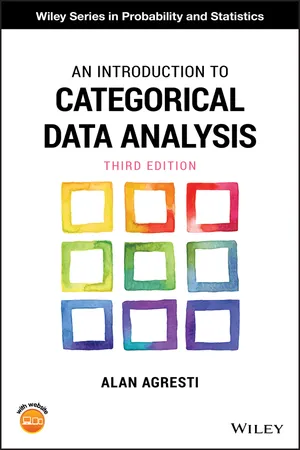
- English
- ePUB (mobile friendly)
- Available on iOS & Android
An Introduction to Categorical Data Analysis
About this book
A valuable new edition of a standard reference
The use of statistical methods for categorical data has increased dramatically, particularly for applications in the biomedical and social sciences. An Introduction to Categorical Data Analysis, Third Edition summarizes these methods and shows readers how to use them using software. Readers will find a unified generalized linear models approach that connects logistic regression and loglinear models for discrete data with normal regression for continuous data.
Adding to the value in the new edition is:
• Illustrations of the use of R software to perform all the analyses in the book
• A new chapter on alternative methods for categorical data, including smoothing and regularization methods (such as the lasso), classification methods such as linear discriminant analysis and classification trees, and cluster analysis
• New sections in many chapters introducing the Bayesian approach for the methods of that chapter
• More than 70 analyses of data sets to illustrate application of the methods, and about 200 exercises, many containing other data sets
• An appendix showing how to use SAS, Stata, and SPSS, and an appendix with short solutions to most odd-numbered exercises
Written in an applied, nontechnical style, this book illustrates the methods using a wide variety of real data, including medical clinical trials, environmental questions, drug use by teenagers, horseshoe crab mating, basketball shooting, correlates of happiness, and much more.
An Introduction to Categorical Data Analysis, Third Edition is an invaluable tool for statisticians and biostatisticians as well as methodologists in the social and behavioral sciences, medicine and public health, marketing, education, and the biological and agricultural sciences.
Frequently asked questions
- Essential is ideal for learners and professionals who enjoy exploring a wide range of subjects. Access the Essential Library with 800,000+ trusted titles and best-sellers across business, personal growth, and the humanities. Includes unlimited reading time and Standard Read Aloud voice.
- Complete: Perfect for advanced learners and researchers needing full, unrestricted access. Unlock 1.4M+ books across hundreds of subjects, including academic and specialized titles. The Complete Plan also includes advanced features like Premium Read Aloud and Research Assistant.
Please note we cannot support devices running on iOS 13 and Android 7 or earlier. Learn more about using the app.
Information
CHAPTER 1
INTRODUCTION
1.1 CATEGORICAL RESPONSE DATA
1.1.1 Response Variable and Explanatory Variables
Table of contents
- Cover
- Title Page
- Copyright
- Preface
- About the Companion Website
- Chapter 1 Introduction
- Chapter 2 Analyzing Contingency Tables
- Chapter 3 Generalized Linear Models
- Chapter 4 Logistic Regression
- Chapter 5 Building and Applying Logistic Regression Models
- Chapter 6 Multicategory Logit Models
- Chapter 7 Loglinear Models for Contingency Tables and Counts
- Chapter 8 Models for Matched Pairs
- Chapter 9 Marginal Modeling of Correlated, Clustered Responses
- Chapter 10 Random Effects: Generalized Linear Mixed Models
- Chapter 11 Classification and Smoothing *
- Chapter 12 A Historical Tour of Categorical Data Analysis *
- Appendix: Software for Categorical Data Analysis
- Brief Solutions to Odd-Numbered Exercises
- Bibliography
- Examples Index
- Subject Index
- End User License Agreement